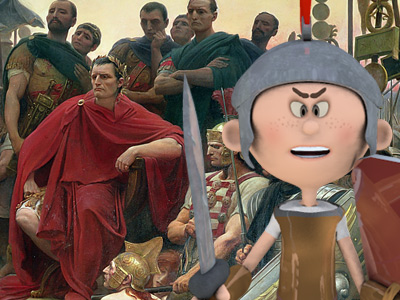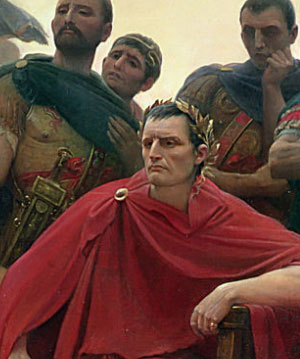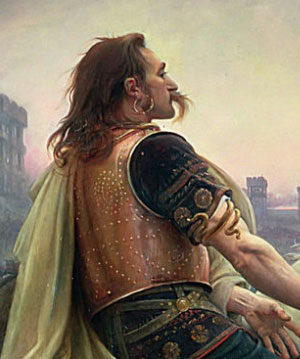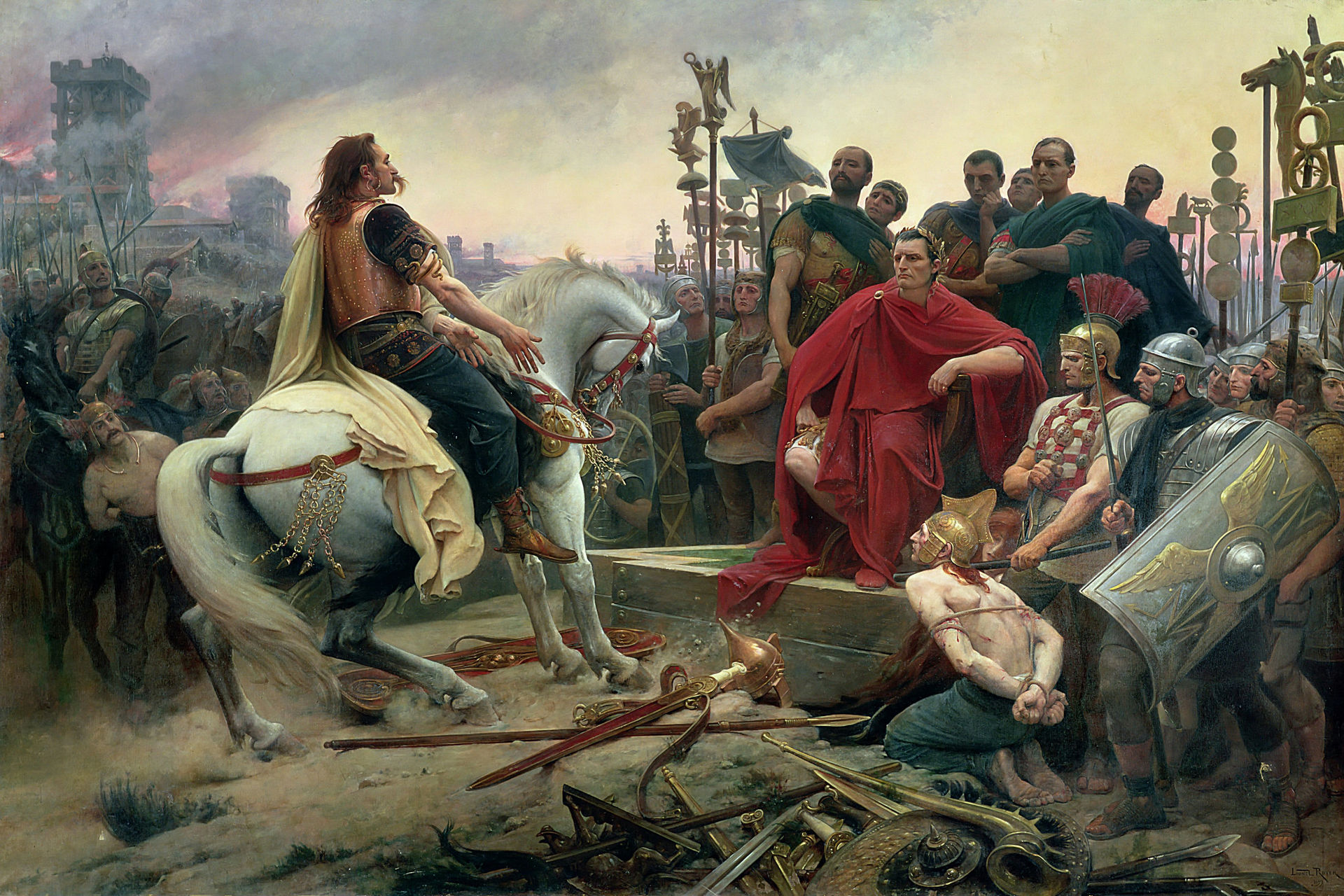Gallic Wars (58–50 BC)
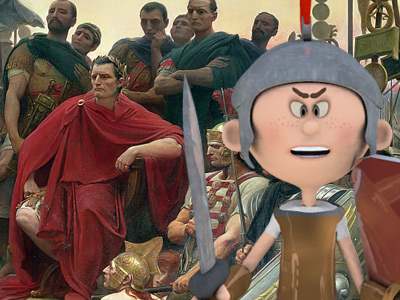
Campaign against the Suebi
In 61 BC, Ariovistus, chieftain of the Suebi tribe and a king from the Germanic peoples, resumed the tribe’s migration from eastern Germania to the Marne and Rhine region. Despite the fact that this migration encroached on Sequani land, the Sequani sought Ariovistus’ allegiance against the Aedui and, in 61 BC, the Sequani rewarded Ariovistus with land following his victory in the Battle of Magetobriga. Ariovistus settled the land with 120,000 of his people. When 24,000 Harudes joined his cause, Ariovistus demanded that the Sequani give him more land to accommodate the Harudes people. This demand concerned Rome because if the Sequani conceded, Ariovistus would be in a position to take all of the Sequani land and attack the rest of Gaul.
Following Caesar’s victory over the Helvetii, the majority of the Gallic tribes congratulated Caesar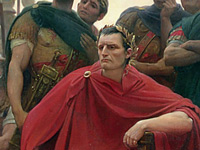 Julius Caesar (100-44 BC), was a Roman politician and general who played a critical role in the events that led to the demise of the Roman Republic and the rise of the Roman Empire. Caesar is considered by many historians to be one of the greatest military commanders in history. Julius Caesar » and sought to meet with him in a general assembly. Diviciacus, the head of the Aeduan government and spokesmen for the Gallic delegation, expressed concern over Ariovistus’ conquests and the hostages he had taken. Diviciacus demanded that Caesar defeat Ariovistus and remove the threat of a Germanic invasion otherwise they would have to seek refuge in a new land. Not only did Caesar have a responsibility to protect the longstanding allegiance of the Aedui, but this proposition presented an opportunity to expand Rome’s borders, strengthen the loyalty within Caesar’s army and establish him as the commander of Rome’s troops abroad.
Julius Caesar (100-44 BC), was a Roman politician and general who played a critical role in the events that led to the demise of the Roman Republic and the rise of the Roman Empire. Caesar is considered by many historians to be one of the greatest military commanders in history. Julius Caesar » and sought to meet with him in a general assembly. Diviciacus, the head of the Aeduan government and spokesmen for the Gallic delegation, expressed concern over Ariovistus’ conquests and the hostages he had taken. Diviciacus demanded that Caesar defeat Ariovistus and remove the threat of a Germanic invasion otherwise they would have to seek refuge in a new land. Not only did Caesar have a responsibility to protect the longstanding allegiance of the Aedui, but this proposition presented an opportunity to expand Rome’s borders, strengthen the loyalty within Caesar’s army and establish him as the commander of Rome’s troops abroad.
The senate had declared Ariovistus a "king and friend of the Roman people" in 59 BC, so Caesar could not declare war on the Suebi tribe. Caesar said that he could not ignore the pain the Aedui had suffered and delivered an ultimatum to Ariovistus demanding that no German cross the Rhine, the return of Aedui hostages and the protection of the Aedui and other friends of Rome. Although Ariovistus assured Caesar that the Aedui hostages would be safe as long as they continued their yearly tribute, he took the position that he and the Romans The Roman Republic was a form of government of Rome and the era of the classical Roman civilization when it was run through public representation of the Roman people. Beginning with the overthrow of the Roman Kingdom (traditionally dated to 509 BC) and ending in 27 BC with the establishment of the Roman Empire, Rome's control rapidly expanded during this period - from the city's immediate surroundings to hegemony over the entire Mediterranean world. were both conquerors and that Rome had no jurisdiction over his actions. With the attack of the Harudes on the Aedui and the report that a hundred clans of Suebi were trying to cross the Rhine into Gaul, Caesar had the justification he needed to wage war against Ariovistus in 58 BC.
The Roman Republic was a form of government of Rome and the era of the classical Roman civilization when it was run through public representation of the Roman people. Beginning with the overthrow of the Roman Kingdom (traditionally dated to 509 BC) and ending in 27 BC with the establishment of the Roman Empire, Rome's control rapidly expanded during this period - from the city's immediate surroundings to hegemony over the entire Mediterranean world. were both conquerors and that Rome had no jurisdiction over his actions. With the attack of the Harudes on the Aedui and the report that a hundred clans of Suebi were trying to cross the Rhine into Gaul, Caesar had the justification he needed to wage war against Ariovistus in 58 BC.
Caesar, learning that Ariovistus intended to seize Vesontio, the largest town of the Sequani, commenced marching his troops toward Vesontio. Some of Caesar’s officers held their posts for political reasons only and had no war experience. Consequently, they suffered from poor morale which threatened Caesar’s campaign. Caesar challenged the officers and their legions, saying that the only legion he could trust was the 10th. With their pride on the line, the other legions followed the 10th’s lead, determined not to be outdone. Consequently, Caesar arrived in Vesontio before Ariovistus.
Ariovistus sent emissaries to Caesar requesting a meeting. They met under a truce at a knoll on the plain. The truce was violated when Caesar learned that German horsemen were edging towards the knoll and throwing stones at his mounted escort. Two days later, Ariovistus requested another meeting. Hesitant to send senior officials, Caesar dispatched Valerius Procillus, his trusted friend, and Caius Mettius, a merchant who had successfully traded with Ariovistus. Insulted, Ariovistus threw the envoys in chains. Ariovistus marched for two days and made camp two miles behind Caesar, thus cutting off Caesar’s communication and supply lines with the allied tribes. Unable to entice Ariovistus into battle, Caesar ordered a second smaller camp to be built near Ariovistus’ position. After the camp was completed, Caesar again challenged Ariovistus and was rewarded when Ariovistus attacked the smaller camp and was repulsed.
The next morning Caesar assembled his allied troops in front of the second camp and advanced his legions in triplex acies (three lines of troops) towards Ariovistus. Each of Caesar’s five legates and his quaestor were given command of a legion. Caesar lined up on the right flank. Ariovistus countered by lining up his seven tribal formations. Caesar was victorious in the battle that ensued due in large part to the charge made by Publius Crassus. As the Germans began to drive back the Roman left flank, Crassus led his cavalry in a charge to restore balance and ordered up the cohorts of the third line. As a result, the whole German line broke and began to flee. Most of Ariovistus’ one-hundred and twenty thousand men were killed. He and what remained of his troops escaped and crossed the Rhine, never to engage Rome in battle again. The Suebi camped near the Rhine returned home. Caesar was victorious.
HISTORY
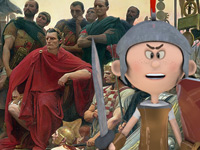
RESOURCES
This article uses material from the Wikipedia article "Gallic Wars", which is released under the Creative Commons Attribution-Share-Alike License 3.0.
© Stories Preschool. All Rights Reserved.
